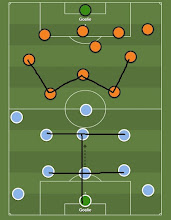The 1991 FIFA U-20 World Cup was unlike any other, marked by unique circumstances surrounding the host nation and the wider historical events of the era.
Unprecedented factors defined the tournament: the surprising performance of teams from Oceania and Asia, extraordinary political developments, and, most notably, the appointment of defending champions Portugal as hosts. To this day, they remain the only reigning champions to have staged the U-20 World Cup—or any FIFA World Cup.
Originally, Nigeria had been awarded hosting rights, but the country was stripped of the tournament after being found guilty of age falsification involving three players at the 1988 Olympic Games. FIFA suspended Nigeria for two years, removing them from international football and transferring hosting rights to Portugal.
Key Facts – 1991 Tournament
* Held from 14 to 30 June, with 16 teams split into four groups.
* Matches were staged in Porto, Lisbon, Braga, Guimarães and Faro.
* For the first and only time, North and South Korea fielded a unified
team, a result of both reaching the final of the 1990 AFC U-20 Championship in
Jakarta. Syria, the third-placed side, claimed the remaining Asian slot.
* Europe was represented by six teams from the 1990 UEFA U-18 Championship:
winners Soviet Union, runners-up Portugal (also hosts), semi-finalists England
and Spain, plus play-off winners Sweden and the Republic of Ireland.
* This was the final FIFA tournament featuring the Soviet Union, which
dissolved soon afterwards.
* The final set a record attendance of 127,000 spectators.
Portugal Retain the Title and Australia’s Breakthrough
Portugal followed in the footsteps of Brazil, who had defended the title in 1983 and 1985, by becoming only the second nation to retain the U-20 World Cup. Led by Luís Figo, the hosts were dominant from the outset, winning all their group games without conceding a goal. In the knockout rounds, Carlos Queiroz’s side defeated Mexico and then Australia to book a place in the final.
The Australians were one of the revelations of the tournament. For the first time, a team from Oceania reached the last four. Paul Okon and his teammates impressed in the group stage, notably defeating the Soviet Union, before edging past Syria in the quarter-finals on penalties. Syria themselves had been a surprise package, advancing unbeaten from a group containing Spain, England and Uruguay, including a 1-0 win over the South Americans.
The final was a tense encounter between Portugal and two-time champions Brazil. Both sides created chances, but the deadlock held and the contest went to penalties after a goalless draw. Portugal prevailed 4-2, lifting their second successive U-20 World Cup and sealing a golden chapter in their football history.
Tournament highlights
Group Stage final standings (The one in bold advanced to the knockout stage)
|
Grup A |
Grup B |
Grup C |
Grup D |
|
Portugal |
Brasil |
Australia |
Spain |
|
Korean Republic |
Mexico |
USSR |
Syria |
|
Ireland |
Sweden |
Egypt |
England |
|
Argentina |
Ivory Coast |
Trinidad & Tobago |
Uruguay |
** = penalties
* = extra time
Quarterfinal:
-
Portugal
vs Mexico 2-1*
-
Brasil
vs Korean Republic 5-1
-
Australia
vs Syria 1-1 (5-4)**
-
Spain
vs USSR 1-3
Semifinal:
-
Portugal
vs Australia 1-0
- Brasil vs USSR 3-0
3rd place playoff: USSR vs Australia 1-1 (5-4) **
Final: Portugal vs Brasil 0-0 (4-2) **
Top Scorer: Serhiy
Scherbakov (USSR) – 5 gol
MVP: Emilio Peixe (Portugal)
From Youth to Stardom
The 1991 edition of the FIFA U-20 World Cup produced relatively few immediate stars, but the graduates who did break through went on to enjoy long, illustrious careers and were virtually irreplaceable for their national sides. Among them were Portugal’s golden duo of Luís Figo and Rui Costa, the heartbeat of the national team throughout the 1990s before the emergence of Cristiano Ronaldo.
Brazil’s legendary left-back Roberto Carlos also featured, as did Trinidad & Tobago icon Dwight Yorke and Australia’s towering goalkeeper Zeljko Kalac. Another alumnus who made his mark not just on the pitch but later on the touchline was Mauricio Pochettino of Argentina, now better known for his managerial career.
Here is the list of players from the 1991 U-20 World Cup who went on to shine at senior level:
|
Players |
World Cup
Edition (senior) |
|
Mauricio
Pocchettino ( |
2002 |
|
Marcelo
Delgado ( |
1998 |
|
Luis Figo ( |
2002, 2006 |
|
Manuel Rui
Costa ( |
2002, 2006 |
|
Jorge Costa ( |
2002 |
|
Abel Xavier ( |
2002 |
|
Nuno Capucho ( |
2002 |
|
Zeljko Kalac ( |
2006 |
|
Dwight Yorke
(Trinidad & Tobago) |
2006 |
|
Roberto Carlos
(Brasil) |
1998, 2002,
2006 |
|
Magnus Hedman
(Sweden) |
1994, 2002 |
|
Patrick
Anderson (Sweden) |
1994, 2002 |
|
Niklas
Alexanderson (Sweden) |
2002, 2006 |
|
Dario Silva ( |
2002 |
|
Paolo Montero
( |
2002 |


Comments
Post a Comment